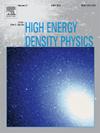引力相互作用与宇宙演化:f(Q,Lm)理论的作用
IF 0.9
3区 物理与天体物理
Q3 PHYSICS, FLUIDS & PLASMAS
引用次数: 0
摘要
本文研究了用函数f(Q,Lm)表示的非度量引力中可行的宇宙学反弹解,其中Q是非度量性,Lm定义了物质-拉格朗日密度。为此,我们分析具有完美物质分布的各向异性平面度规,以探究宇宙奥秘。我们通过考虑两种不同的f(Q,Lm)函数形式来研究这一引力建议对宇宙演化的影响。进一步,我们研究了不同宇宙学参数的行为,以验证可行的宇宙学弹跳解的存在性。分析表明,该方法不满足零能条件,表明在该扩展理论框架下可以解决奇异性问题。我们的发现表明,这种修正的引力理论为标准宇宙学提供了另一种框架,为引力相互作用和早期宇宙演化提供了见解。本文章由计算机程序翻译,如有差异,请以英文原文为准。
Gravitational interplay and cosmic evolution: The role of f(Q,Lm) theory
This manuscript investigates the viable cosmological bounce solutions in the non-metric gravity represented by the function , where is non-metricity and defines the matter-Lagrangian density. For this purpose, we analyze anisotropic flat metric with a perfect matter distribution to examine the cosmic mysteries. We study the impact of this gravitational proposal on the cosmic evolution by considering two distinct functional forms. Further, we investigate the behavior of different cosmological parameters to investigate the existence of viable cosmological bounce solutions. The analysis shows that the null energy condition is violated, which indicates that the singularity problem can be addressed in this extended theoretical framework. Our findings suggest that this modified gravitational theory provides an alternative framework to standard cosmology, offering insights into gravitational interactions and the early cosmic evolution.
求助全文
通过发布文献求助,成功后即可免费获取论文全文。
去求助
来源期刊

High Energy Density Physics
PHYSICS, FLUIDS & PLASMAS-
CiteScore
4.20
自引率
6.20%
发文量
13
审稿时长
6-12 weeks
期刊介绍:
High Energy Density Physics is an international journal covering original experimental and related theoretical work studying the physics of matter and radiation under extreme conditions. ''High energy density'' is understood to be an energy density exceeding about 1011 J/m3. The editors and the publisher are committed to provide this fast-growing community with a dedicated high quality channel to distribute their original findings.
Papers suitable for publication in this journal cover topics in both the warm and hot dense matter regimes, such as laboratory studies relevant to non-LTE kinetics at extreme conditions, planetary interiors, astrophysical phenomena, inertial fusion and includes studies of, for example, material properties and both stable and unstable hydrodynamics. Developments in associated theoretical areas, for example the modelling of strongly coupled, partially degenerate and relativistic plasmas, are also covered.
 求助内容:
求助内容: 应助结果提醒方式:
应助结果提醒方式:


